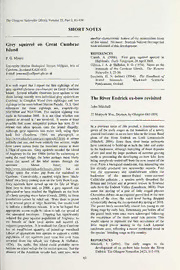
Grey squirrel on Great Cumbrae Island PDF
Preview Grey squirrel on Great Cumbrae Island
The GlasgowNaturalist(2011), Volume 25, Part 3, 83-108 SHORT NOTES another characteristic feature ofthe mammalian fauna Grey squirrel on Great Cumbrae ofthis island. No more. Scottish Natural Heritage has been informed ofthis development. Island REFERENCES P. G. Moore Cramb, A. (2008). First grey squirrel spotted in Highlands. Daily Telegraph, 28 April 2008. University Marine Biological Station Millport, Isle of Gibson, J. A. & Shillaker, R. O. (1974). Notes on the Cumbrae, Scotland KA28 OEG mammals of the Cumbrae Islands. The Western E-mail: [email protected] Naturalist3, 23-30. Southern, H. N. (editor) (1964). The Handbook of British Mammals. Blackwell Scientific Publications, Oxford. It is with regret that I report the first sightings of the grey squirrel (Sciurus carolinensis) on Great Cumbrae Island. Several reliable observers have spoken to me about having recently seen individual grey squirrels on The River Endrick ox-bow revisited Cumbrae: in Craigilea Wood (two sightings) and two sightings in the trees behind Marine Parade. O. S. Grid John Mitchell references for these sightings are, respectively: NS176564 and NS173546. The earliest sighting was made in November 2008. It is not clear whether one 22 MuirparkWay, Drymen, by Glasgow G63 ODX squirrel or several is / are involved. It seems at least possible that some misguided person has seen fit to release this alien species onto the island illegally. In a previous issue of this journal, a description was Although grey squirrels can swim well, using their given of the early stages in the transition of a newly back feet (Southern, 1964; see photograph at created backwater to an ox-bow lake in the lower flood http:/7www.uksafari.comy'grevsquiiTels5.htm) it seems plain of the River Endrick on Loch Lomondside unlikely that one, and most unlikely that several, might (Mitchell, 2004). Since then, river borne sediments have swum across from the mainland across at least have continued to build-up at both the inlet and outlet 1.75km ofopen sea. Grey squirrels invaded the island to the backwater, although trampling ofthese deposits ofAnglesey in the late 1960s (either by swimming or of silt and sand by large numbers of summer grazing using the road bridge; the latter perhaps more likely cattle is preventing the developing ox-bow lake from given the speed of the tidal stream through the being completely sealed-offfrom the new course ofthe narrower Menai Strait; see river. From a biological standpoint, this interesting site http://www.redsquirrels.iiifo/boui'itv.html) but no has already produced two noteworthy records. First bridge spans the wider gap from the mainland to was the appearance and establishment within the Cumbrae. Conceivably, a squirrel might have ‘hitch- backwater of the narrow-fruited water-starwort hiked’ on a lorry coming over on the ferry from Largs. Callitriche palustris , a species newly described for Grey squirrels have turned up on the Isle of Wight Britain and Ireland and at present known in Scotland from time to time and, in 2008, a grey squirrel was only from the Endrick Valley (Lansdown, 2008). Then speculated to have reached the Highlands on the back came the nesting of a pair of little ringed plovers ofa lorry carrying straw bales (Cramb, 2008), so these Charadrius dubius on an exposed gravel bed in the new possibilities cannot be ruled out. Were there to prove stretch of the river, the water level having dropped to be several greys at large, however, this would tend substantially during the exceptional dry spring of2010. to indicate a deliberate release. It is to be hoped that The parent birds successfully reared two young to the appropriate action might be taken to halt the spread of flying stage by earlyJuly, fortuitouslyjust before all of this unwanted interloper. Trapping has significantly the gravel beds were once more submerged following reduced the grey squirrel population of Anglesey, to the resumption of the more usual rain pattern. This the benefit of their local native red squirrel {S. would appear to represent the first occurrence of the vulgaris) population. It is realised that Great Cumbrae little ringed plover nesting in the Loch Lomond has an insufficient quantity of joined-up woodland catchment area, reflecting a recent northward trend in habitat of appropriate tree species to support a viable the species’ breedingrange in this country. population of red squirrels (and none has ever been recorded from the island; see Gibson & Shillaker, REFERENCES 1974). So, sadly, this island could probably never Mitchell, J. (2004). The early stages in the become an island refuge forthe native species. But the development of an ox-bow lake beside the River absence ofthe American invader had, until now, been Endrick. The GlasgowNaturalist24(2), 115-118. 83
